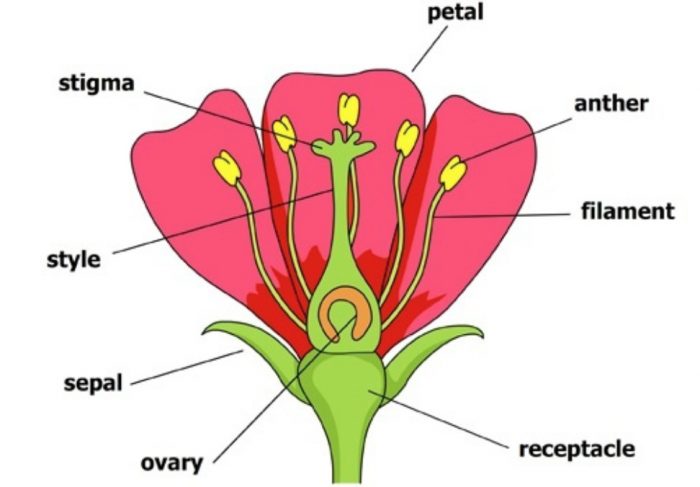Question 1 Draw a labelled diagram of flower showing its various parts?
Question 2 What is meant by unisexual flowers? Give examples?
Question 3 What is meant by bisexual flowers? Give examples?
Question 4 What are the stamen and pistil in a flower?
Question 5 What is the function of sepals and petals in flower?
Contents
Sexual Reproduction in Plants
The plants that have flowers are called flowering plants. Most of the flowering plants reproduce by sexual reproduction method involving the fusion of sex cells called gametes.
Flowers are the reproductive parts of a plant. Flowers contain the sexual reproductive organs of a plant. The function of a flower is to make male and female gametes, and to ensure that fertilisation will take place to make seeds for growing new plants.
The sexual reproduction in plants involves the fusion (combination) of male and female gametes of the plant which leads to the formation of the seeds of the plant. These seeds can then be used to grow new plants.
Structure of Flower
Main parts of Flower
The main parts of a flower are : Receptacle, Sepals, Petals, Stamen and Pistil.
(1) Receptacle
The base of a flower to which all the parts of a flower are attached is called receptacle.
(2) Sepals
The green, leaf-like parts in the outermost circle of a flower are called sepals .All the sepals taken together are called calyx. The function of sepals (or calyx) is to protect the flower in its initial stages when it is in the form of a flower bud.
(3) Petals
The colourful parts of a flower are called petals. The petals lie inside the sepals. All the petals taken together are called ‘corolla. The petals are usually scented. The function of petals is to attract insects (for pollination) and to protect the reproductive organs which are at the centre of the flower.
(4) Stamen
The little stalks with swollen tops just inside the ring of petals in a flower are called stamens. Stamen is the male reproductive organ of the plant . The stamen is made of two parts: a filament and an anther. The stalk of stamen is called filament and the swollen top of stamen is called anther. Anther makes the pollen grains and stores them. Pollen grains are exposed when the anther ripens and splits. Pollen grains appear to be yellow, powder like substance to us. Pollen grains contain the male gametes (or male sex cells) of the plant. Pollen grains generally have a tough protective coat which prevents them from drying up. Flower usually has a number of stamens in it.
(5) Pistil
In the centre of a flower, there is a flask-shaped organ called pistil. Pistil is the female reproductive organ of the plant. A pistil, is made of three parts : stigma, style and ovary.
The top part of pistil is called stigma. Stigma is for receiving the pollen grains from the anther of stamen (during pollination).
The middle part of pistil is called style. Style is a tube which connects stigma to the ovary.
The swollen part at the bottom of a pistil is called ovary. The ovary makes ovules and stores them. Ovules contain the female gametes (or female sex cells) of the plant. The ovary contains one or more ovules.Each ovule contains only one female gamete of the plant. The female gamete of the plant which is present inside the ovule is called ‘egg’.
The female reproductive organ of the plant called pistil is also known as carpel. The female organs called pistils are surrounded by a number of male organs called stamens in the flower.
Male and female reproductive organs of a plant may be present in the same flower or in different flowers. Depending on this, a flower may be unisexual or bisexual.
Unisexual Flowers
(1) The flowers which contain only one reproductive organ (either male or female) are called unisexual flowers. The unisexual flowers contain either male organ ‘stamen’ or female organ pistil. Both male and female unisexual flowers may be present in the same plant or in different plants.
The plants such as papaya, watermelon, corn, and cucumber have unisexual flowers.
Bisexual Flowers
(2) The flowers which contain both the reproductive organs (male as well as female) are called bisexual flowers. This means that the bisexual flowers contain both, the male organ stamen as well as the female organ pistil.
The plants such as rose, mustard, Hibiscus and petunia have bisexual Flower.
A new seed of the plant is formed when the male gamete present in a pollen grain unites with the female gamete present in the ovule.

I am in class 7. I hAve this chapter also in my science book
Thank you nice website
Nice honey
This is so useful, thank you for the explanation, I am in Grade 4
good nice very working well ok keep it up